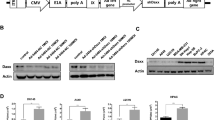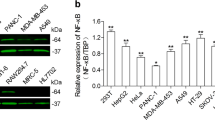Abstract
RNA interference, due to its target specificity, may be highly effective as a novel therapeutic modality, but direct delivery of synthetic small interfering RNA still remains a major obstacle for this approach. To induce long-term expression and specific gene silencing, novel delivery vector system is also required. In this study, we have generated an efficient oncolytic adenovirus (Ad)-based short hairpin (shRNA) expression system (Ad-ΔB7-U6shIL8) against IL-8, a potent proangiogenic factor. To demonstrate IL-8-specificity of this newly engineered Ad-based shRNA, we also manufactured replication-incompetent Ads (Ad-ΔE1-CMVshIL8 and Ad-ΔE1-U6shIL8) under the control of the cytomegalovirus (CMV) and U6 promoters, respectively. Ad-ΔE1-U6shIL8 was highly effective in reducing IL-8 expression, and was much more effective in driving IL-8-specific shRNA than the CMV promoter-driven vector. The reduced IL-8 expression then translated into decreased angiogenesis in vitro as measured by migration, tube formation and rat aortic ring sprouting assays. In addition to its effect on endothelial cells, Ad-ΔE1-U6shIL8 also effectively suppressed the migration and invasion of cancer cells. In vivo, intratumoral injection of Ad-ΔB7-U6shIL8 significantly inhibited the growth of Hep3B and A549 human tumor xenografts. Histopathological analysis of Ad-ΔB7-U6shIL8-treated tumors revealed an increase in apoptotic cells and a reduction in vessel density. Finally, Ad-ΔB7-U6shIL8 was also shown to inhibit the growth of disseminated MDA-MB-231 breast cancer metastases. Taken together, these findings demonstrate the utility and antitumor effectiveness of oncolytic Ad expressing shRNA against IL-8.
This is a preview of subscription content, access via your institution
Access options
Subscribe to this journal
Receive 12 print issues and online access
$259.00 per year
only $21.58 per issue
Buy this article
- Purchase on Springer Link
- Instant access to full article PDF
Prices may be subject to local taxes which are calculated during checkout









Similar content being viewed by others
Accession codes
References
Hanahan D, Weinberg RA . The hallmarks of cancer. Cell 2000; 100: 57–70.
Kim KJ, Li B, Winer J, Armanini M, Gillett N, Phillips HS et al. Inhibition of vascular endothelial growth factor-induced angiogenesis suppresses tumour growth in vivo. Nature 1993; 362: 841–844.
Koch AE, Polverini PJ, Kunkel SL, Harlow LA, DiPietro LA, Elner VM et al. Interleukin-8 as a macrophage-derived mediator of angiogenesis. Science 1992; 258: 1798–1801.
Hu DE, Hori Y, Fan TP . Interleukin-8 stimulates angiogenesis in rats. Inflammation 1993; 17: 135–143.
Shi Q, Abbruzzese JL, Huang S, Fidler IJ, Xiong Q, Xie K . Constitutive and inducible interleukin 8 expression by hypoxia and acidosis renders human pancreatic cancer cells more tumorigenic and metastatic. Clin Cancer Res 1999; 5: 3711–3721.
Xie K . Interleukin-8 and human cancer biology. Cytokine Growth Factor Rev 2001; 12: 375–391.
Arenberg DA, Kunkel SL, Polverini PJ, Glass M, Burdick MD, Strieter RM . Inhibition of interleukin-8 reduces tumorigenesis of human non-small cell lung cancer in SCID mice. J Clin Invest 1996; 97: 2792–2802.
Arici A, Seli E, Zeyneloglu HB, Senturk LM, Oral E, Olive DL . Interleukin-8 induces proliferation of endometrial stromal cells: a potential autocrine growth factor. J Clin Endocrinol Metab 1998; 83: 1201–1205.
Mian BM, Dinney CP, Bermejo CE, Sweeney P, Tellez C, Yang XD et al. Fully human anti-interleukin 8 antibody inhibits tumor growth in orthotopic bladder cancer xenografts via down-regulation of matrix metalloproteases and nuclear factor-kappaB. Clin Cancer Res 2003; 9: 3167–3175.
Shen C, Buck AK, Liu X, Winkler M, Reske SN . Gene silencing by adenovirus-delivered siRNA. FEBS Lett 2003; 539: 111–114.
Elbashir SM, Harborth J, Lendeckel W, Yalcin A, Weber K, Tuschl T . Duplexes of 21-nucleotide RNAs mediate RNA interference in cultured mammalian cells. Nature 2001; 411: 494–498.
Brummelkamp TR, Bernards R, Agami R . A system for stable expression of short interfering RNAs in mammalian cells. Science 2002; 296: 550–553.
Fire A, Xu S, Montgomery MK, Kostas SA, Driver SE, Mello CC . Potent and specific genetic interference by double-stranded RNA in Caenorhabditis elegans. Nature 1998; 391: 806–811.
Jaesung Kim J-HK, Kyung-Ju Choi, Pyung-Hwan Kim, Chae-Ok Yun . E1A- and E1B-double mutant replicating adenovirus elicits enhanced oncolytic and anti-tumor effects. Hum Gene Ther 2007; 18: 773–786.
Boden D, Pusch O, Lee F, Tucker L, Shank PR, Ramratnam B . Promoter choice affects the potency of HIV-1 specific RNA interference. Nucleic Acids Res 2003; 31: 5033–5038.
Kawasaki H, Taira K . Short hairpin type of dsRNAs that are controlled by tRNA(Val) promoter significantly induce RNAi-mediated gene silencing in the cytoplasm of human cells. Nucleic Acids Res 2003; 31: 700–707.
Makinen PI, Koponen JK, Kärkkäinen AM, Malm TM, Pulkkinen KH, Koistinaho J et al. Stable RNA interference: comparison of U6 and H1 promoters in endothelial cells and in mouse brain. J Gene Med 2006; 8: 433–441.
Paddison PJ, Caudy AA, Bernstein E, Hannon GJ, Conklin DS . Short hairpin RNAs (shRNAs) induce sequence-specific silencing in mammalian cells. Genes Dev 2002; 16: 948–958.
Yoo JY, Kim JH, Kwon YG, Kim EC, Kim NK, Choi HJ et al. VEGF-specific short hairpin RNA-expressing oncolytic adenovirus elicits potent inhibition of angiogenesis and tumor growth. Mol Ther 2007; 15: 295–302.
Zhou Z, Zhou RR, Guan H, Bucana CD, Kleinerman ES . E1A gene therapy inhibits angiogenesis in a Ewing's sarcoma animal model. Mol Cancer Ther 2003; 2: 1313–1319.
Saito Y, Sunamura M, Motoi F, Abe H, Egawa S, Duda DG et al. Oncolytic replication-competent adenovirus suppresses tumor angiogenesis through preserved E1A region. Cancer Gene Ther 2006; 13: 242–252.
Matsui Y, Kobayashi N, Nishikawa M, Takakura Y . Sequence-specific suppression of mdr1a/1b expression in mice via RNA interference. Pharm Res 2005; 22: 2091–2098.
Tran N, Cairns MJ, Dawes IW, Arndt GM . Expressing functional siRNAs in mammalian cells using convergent transcription. BMC Biotechnol 2003; 3: 21.
Robb GB, Brown KM, Khurana J, Rana TM . Specific and potent RNAi in the nucleus of human cells. Nat Struct Mol Biol 2005; 12: 133–137.
Wyatt CA, Geoghegan JC, Brinckerhoff CE . Short hairpin RNA-mediated inhibition of matrix metalloproteinase-1 in MDA-231 cells: effects on matrix destruction and tumor growth. Cancer Res 2005; 65: 11101–11108.
Yang G, Cai KQ, Thompson-Lanza JA, Bast Jr RC, Liu J . Inhibition of breast and ovarian tumor growth through multiple signaling pathways by using retrovirus-mediated small interfering RNA against Her-2/neu gene expression. J Biol Chem 2004; 279: 4339–4345.
Gurzov EN, Izquierdo M . RNA interference against Hec1 inhibits tumor growth in vivo. Gene Ther 2006; 13: 1–7.
Banan M, Puri N . The ins and outs of RNAi in mammalian cells. Curr Pharm Biotechnol 2004; 5: 441–450.
Unwalla HJ, Li MJ, Kim JD, Li HT, Ehsani A, Alluin J et al. Negative feedback inhibition of HIV-1 by TAT-inducible expression of siRNA. Nat Biotechnol 2004; 22: 1573–1578.
Tiscornia G, Singer O, Ikawa M, Verma IM . A general method for gene knockdown in mice by using lentiviral vectors expressing small interfering RNA. Proc Natl Acad Sci USA 2003; 100: 1844–1848.
Song J, Pang S, Lu Y, Chiu R . Poly(U) and polyadenylation termination signals are interchangeable for terminating the expression of shRNA from a pol II promoter. Biochem Biophys Res Commun 2004; 323: 573–578.
Xia H, Mao Q, Paulson HL, Davidson BL . siRNA-mediated gene silencing in vitro and in vivo. Nat Biotechnol 2002; 20: 1006–1010.
Xia H, Mao Q, Eliason SL, Harper SQ, Martins IH, Orr HT et al. RNAi suppresses polyglutamine-induced neurodegeneration in a model of spinocerebellar ataxia. Nat Med 2004; 10: 816–820.
Zhou H, Xia XG, Xu Z . An RNA polymerase II construct synthesizes short-hairpin RNA with a quantitative indicator and mediates highly efficient RNAi. Nucleic Acids Res 2005; 33: e62.
Snove Jr O, Rossi JJ . Expressing short hairpin RNAs in vivo. Nat Methods 2006; 3: 689–695.
Huynh T, Walchli S, Sioud M . Transcriptional targeting of small interfering RNAs into cancer cells. Biochem Biophys Res Commun 2006; 350: 854–859.
Bergers G, Brekken R, McMahon G, Vu TH, Itoh T, Tamaki K et al. Matrix metalloproteinase-9 triggers the angiogenic switch during carcinogenesis. Nat Cell Biol 2000; 2: 737–744.
Blavier L, Lazaryev A, Dorey F, Shackleford GM, DeClerck YA . Matrix metalloproteinases play an active role in Wnt1-induced mammary tumorigenesis. Cancer Res 2006; 66: 2691–2699.
Bergers G, Benjamin LE . Tumorigenesis and the angiogenic switch. Nat Rev Cancer 2003; 3: 401–410.
Inoue K, Slaton JW, Kim SJ, Perrotte P, Eve BY, Bar-Eli M et al. Interleukin 8 expression regulates tumorigenicity and metastasis in human bladder cancer. Cancer Res 2000; 60: 2290–2299.
Tamatani T, Azuma M, Ashida Y, Motegi K, Takashima R, Harada K et al. Enhanced radiosensitization and chemosensitization in NF-kappaB-suppressed human oral cancer cells via the inhibition of gamma-irradiation- and 5-FU-induced production of IL-6 and IL-8. Int J Cancer 2004; 108: 912–921.
Green M, Daesch GE . Biochemical studies on adenovirus multiplication. II. Kinetics of nucleic acid and protein synthesis in suspension cultures. Virology 1961; 13: 169–176.
Jaffe EA, Nachman RL, Becker CG, Minick CR . Culture of human endothelial cells derived from umbilical veins. Identification by morphologic and immunologic criteria. J Clin Invest 1973; 52: 2745–2756.
Yun CO, Kim E, Koo T, Kim H, Lee YS, Kim JH . ADP-overexpressing adenovirus elicits enhanced cytopathic effect by induction of apoptosis. Cancer Gene Ther 2005; 12: 61–71.
Chartier C, Degryse E, Gantzer M, Dieterle A, Pavirani A, Mehtali M . Efficient generation of recombinant adenovirus vectors by homologous recombination in Escherichia coli. J Virol 1996; 70: 4805–4810.
Nicosia RF, Ottinetti A . Modulation of microvascular growth and morphogenesis by reconstituted basement membrane gel in three-dimensional cultures of rat aorta: a comparative study of angiogenesis in matrigel, collagen, fibrin, and plasma clot. In vitro Cell Dev Biol 1990; 26: 119–128.
de Jong JS, van Diest PJ, Baak JP . Heterogeneity and reproducibility of microvessel counts in breast cancer. Lab Invest 1995; 73: 922–926.
Marson LP, Kurian KM, Miller WR, Dixon JM . Reproducibility of microvessel counts in breast cancer specimens. Br J Cancer 1999; 81: 1088–1093.
Acknowledgements
This study was supported by grants from the Korea Research Foundation, Republic of Korea (KRF-2005-042-C00148, C-OY), the Korea Biotech R&D Group of MOST (M10416130002-04N1613-00210, C-OY) and KOSEF through National Core Research Center for Nanomedical Technology (R15-2004-024-02001-0, C-OY and J-HK). JYY, JK, J-HH, SNZ and Y-AK are graduate students sponsored by the Brain Korea 21 Project for Medical Science, Yonsei University College of Medicine, Seoul, South Korea.
Author information
Authors and Affiliations
Corresponding author
Rights and permissions
About this article
Cite this article
Yoo, J., Kim, JH., Kim, J. et al. Short hairpin RNA-expressing oncolytic adenovirus-mediated inhibition of IL-8: effects on antiangiogenesis and tumor growth inhibition. Gene Ther 15, 635–651 (2008). https://doi.org/10.1038/gt.2008.3
Received:
Revised:
Accepted:
Published:
Issue Date:
DOI: https://doi.org/10.1038/gt.2008.3
Keywords
This article is cited by
-
Efficacy of combining ING4 and TRAIL genes in cancer-targeting gene virotherapy strategy: first evidence in preclinical hepatocellular carcinoma
Gene Therapy (2018)
-
Mortalin deficiency suppresses fibrosis and induces apoptosis in keloid spheroids
Scientific Reports (2017)
-
Combined therapy with oncolytic adenoviruses encoding TRAIL and IL-12 genes markedly suppressed human hepatocellular carcinoma both in vitro and in an orthotopic transplanted mouse model
Journal of Experimental & Clinical Cancer Research (2016)
-
Efficient lung orthotopic tumor-growth suppression of oncolytic adenovirus complexed with RGD-targeted bioreducible polymer
Gene Therapy (2014)
-
Local sustained delivery of oncolytic adenovirus with injectable alginate gel for cancer virotherapy
Gene Therapy (2013)



